This isn’t “technically” a stucco wall. Its a variation on Wattle and Daub. Wattles were woven sticks or reeds inside a wooden framework and then covered with Daub (clay, dung, whatever was available locally.) This provided insulation and sealed the gaps against the weather. I’m sure that I’ve seen a similar technique applied to loose stone stacked between wood support beams but couldn’t find anything. Since I live in a fantasy world anyway, I thought, “What the hell! Slap me in a dress and call me Alice.” Err… I mean, “cover it in spackle and pretend its real”. I also figured more people would know what I’m talking about if I called it stucco. I’m very pleased with the result and to heck with reality.
The finished product (above) is not to scale, if I was doing this on a model I’d avoid the big wood planks so close together. I used 3x 3″ fieldstone blocks from HirstArts and stacked them. Time to finish this was a about 2 hours because I didn’t know what I was doing and I had to wait for the spackling compound to dry.
List of Materials
- 3x 3″ Fieldstone Hirst Blocks
- 4x 3″ Hirst Wood Planks
- 4x 1″ Hirst Wood Boards
- DAP DryDex Spackling Compound
- Vallejo Paints
- Charred Brown
- Cobra Leather
- Bone White
- Scorpy Green
- Beasty Brown
- Sombre Grey
- Cold Grey
- Skull White
- Pointy Stick (Some sort of carving tool)
- Brown Ink
- Weldbond (Glue)
First a note, you can click on any of the small picks to see a larger version
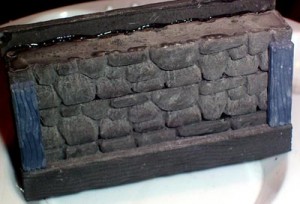
Basically, I started with a concept and thought that I wasn’t going to spend a lot of time doing this if it was going to look really ugly. I glued 3 fieldstone blocks on top of each other. I glued the baseboard and the upright boards in place. As you can see, its not an exact fit. Didn’t care.
I use black Flowstone mainly so when I applied the Spackling Compound (DAP DryDex) the camera exposed to the white and made the stone look a lot blacker than it really is. Anyway, I put a couple of blobs in place and smoothed it with the carving tool I tried to keep a fairly rough texture and left a couple of bare areas. The DryDex goes on Pink but drys white so I knew exactly when it was ready.
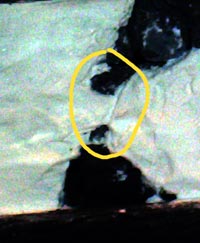
The circled area shows a “manufactured” crack. I used my carving tool (Pointy Stick) to connect the two main areas of bare rock. I also cleaned up all the “screwed up” bits where I got Spackle on the wood, etc. I emphasized the edges where the Daub fell off by roughing it up.
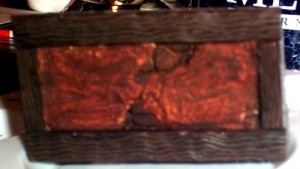
I have to apologize, a couple of the pics are fuzzy (Note to self — Make sure there is nothing in the background of the thing being photographed that may mess up the autofocus). I’ve included them to show color, not details. I’m a big fan of INK so I inked the whole thing with full strength Brown Ink. At full strength, the ink pools and goes on blotchy. This is a good thing. Normally, I mix a little Jet Dry and Water in to make the ink flow evenly and soak into everything (The Jet Dry breaks the surface tension of the mix). Not the effect I wanted in this case.
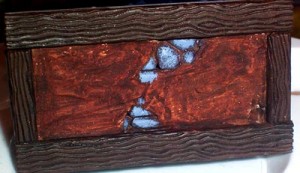
I painted the wood Charred Brown and picked out the stones in Sombre Grey (Bluish Grey). I didn’t touch the Daub yet.
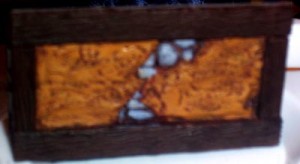
Unfortunately, this is the worst picture in terms of quality but its sort of the most important. This is the color that really sets up the others that will be painted on top of it. I roughly painted the Daub with Cobra Leather. Its sort of half way between a normal wet brush and a dry brush. I didn’t want to get in all the cracks but wanted strong color. I also went really close to the edges.
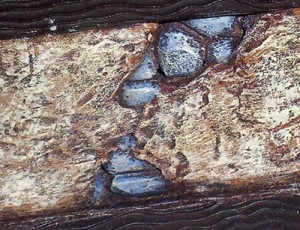
Here’s a close up of the next step. The stones are dry brushed carefully with Cold Grey. The Daub is given several dry brushes of Bone White. The edges where the daub meets the wood is avoided. The corners are really avoided. This is suppose to look dirty.
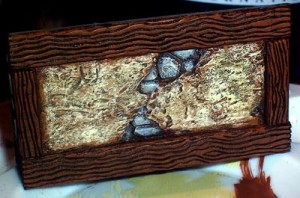
The wood is now given a coating of Beasty Brown. Again, not really a dry brush but I avoid filling in the cracks. The stone is given a light dusting of Bone White.
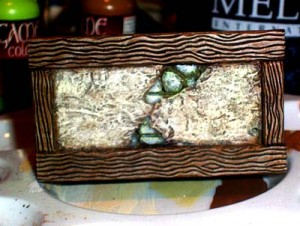
OK, here’s the trickiest part to explain. The wood is given a coating of Cobra leather. I then give the wood a very light wash of very weak Brown Ink to help blend in the colors.
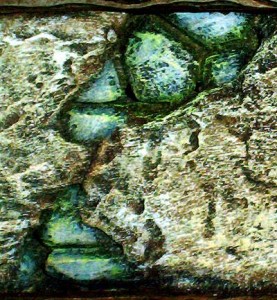
The cracks of the stone and the edges of the fallen Daub (Stucco, Spackling, whatever) is given a dry brush of Scorpy Green. I’ve included a close up because its one of those things that you have to see. The wood is also given a final dry brushing of Bone White. Even though the last two pics look the same, the last has a very subtle touch up of Brown Ink and a little bit of extra green dry brushing.
Hopefully, I been able to translate the process well enough the people can duplicate it. I’m going to attempt this on a larger scale soon in a basement structure.
* Note: This is a reprint of an original Dungeon Crawlers Article
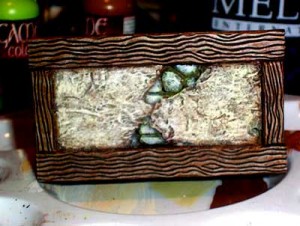
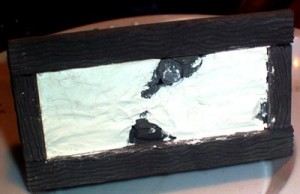
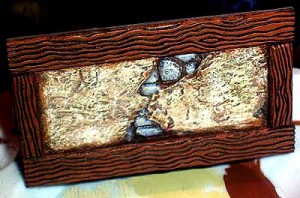

One Response
Stay in touch with the conversation, subscribe to the RSS feed for comments on this post.
Continuing the Discussion
You must be logged in to post a comment.